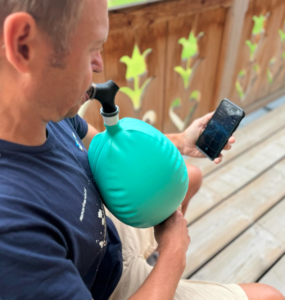
We would like to highlight an article written by Heidi Goldman in the November addition of the Harvard Health Letter. Read the letter here.
As winter approaches, so does the season of colds, flus, and other respiratory illnesses. While many focus on preventing illness through vaccinations, handwashing, and proper hygiene, it is equally important to address what happens after a respiratory illness has struck. Two of the most common post-infection issues are increased mucus secretions and respiratory muscle weakness—both of which can significantly impact recovery and overall health.
The Role of Proper Breathing and Mucus Clearance
After a respiratory illness, mucus production often increases as the body works to expel the infection. However, when mucus builds up in the airways, it can cause discomfort, prolong recovery, and even lead to further complications like secondary infections.
To promote mucus clearance, proper breathing techniques are essential. Diaphragmatic breathing, which emphasizes the use of the diaphragm for deep and cleansing breaths, helps to mobilize mucus and improve oxygen exchange. Additionally, incorporating specific techniques such as vibrations and forced exhalation can aid in loosening and expelling mucus. The goal is to help the body cough up infected mucus and remove it from the airways rather than swallowing it.
These techniques can be done with the guidance of a physical therapist or by using an inexpensive flutter valve device. A flutter valve produces vibrations that stimulate the chest wall, helping to mobilize secretions and make them easier to expel. Regular use of these methods not only clears mucus but also supports better lung function during recovery.
Strengthening Respiratory Muscles
The second major concern after a respiratory illness is respiratory muscle weakness. The muscles responsible for inspiration, particularly the diaphragm, can lose strength and endurance following illness. Research has shown that these muscles can be strengthened through targeted, repetitive training.
However, most respiratory training devices on the market have limitations. Many allow for only 5-10 breaths of training at a time before users experience symptoms of hyperventilation, which limits their effectiveness. This is where the Breathe Way Better (BWB) device stands out. By controlling CO2 levels, the BWB allows for extended training sessions without the risk of hyperventilation. This makes it a valuable tool for patients recovering from illnesses like Covid-19, who need to rebuild respiratory muscle strength and regain full range of motion.
Before starting any respiratory muscle training, it’s crucial to master diaphragmatic breathing. Good technique forms the foundation for effective training and ensures that the exercises are both safe and beneficial. Once proper breathing patterns are established, training the respiratory system with tools like the BWB can accelerate recovery and improve overall respiratory health.
Take Control of Your Winter Wellness
This winter, don’t let respiratory illnesses keep you down. By prioritizing proper breathing techniques, clearing mucus effectively, and strengthening your respiratory muscles, you can recover faster and breathe easier. Whether you work with a physical therapist or use accessible tools like a flutter valve or the BWB device, these proactive steps can make a significant difference in your health and quality of life.



